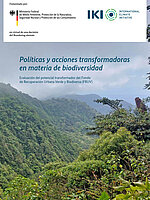Biodiversity – protected, utilised and a global target

From 30 May 2023, the photo exhibition ‘Biodiversity – protected, utilised and a global target’ will also be on display at the IKI project management agency Zukunft – Umwelt – Gesellschaft (ZUG) gGmbH.
Minister Steffi Lemke of the German Federal Ministry of Environment opened the exhibition to mark the International Day for Biological Diversity on 22 May 2023. The exhibition will be on displayed in various places nationwide – with a first stop of the tour being at the Federal Ministry of Environment in Berlin.

Launched to coincide with this year’s International Day for Biological Diversity, titled ‘From agreement to action: build back biodiversity’, the exhibition shows how projects from the International Climate Initiative (IKI) are working to fulfil the 23 targets of the Kunming-Montreal Global Biodiversity Framework (GBF). The exhibition was organised by the IKI project ‘Support for the design and initial implementation steps for the new Global Biodiversity Framework’, implemented by the Gesellschaft für internationale Zusammenarbeit (GIZ).
The IKI implements biodiversity-relevant projects worldwide

The project team selected one photo from different IKI projects for each of the GBF’s 23 targets. As examples, they show the restoration of coastal areas in Vietnam, the sustainable cultivation of cocoa in Columbia and measures to protect ecosystems in the Mesoamerican Reef, illustrating the opportunities that arise when biodiversity is protected and used sustainably. In this way, the exhibition makes the GBF targets visible to the public and raises awareness about the topic. The photo exhibition is planned as a touring exhibition: after the ZUG premises, it will be moved to other locations within Germany.
Kunming-Montreal Global Biodiversity Framework

Last year, the adoption of the Kunming-Montreal GBF constituted a new milestone for biodiversity conservation worldwide. The GBF, which was negotiated within the scope of the Convention on Biological Diversity (CBD), sets out 4 long-term goals and 23 targets that the global community has established with the aim of halting or reversing the loss of natural habitats and biodiversity by 2030. Some of these targets require that; at least 30 percent of global terrestrial and marine areas must be conserved and managed by 2030 (target 3), pollution risks to people and nature from pesticides and hazardous chemicals must be at least halved by 2030 (target 7) and substances harmful for biodiversity must be reduced by USD 500 billion a year (target 18). Synergy effects between climate change mitigation and biodiversity conservation should be better utilised (target 8), while vulnerable groups, such as indigenous populations, women and girls, should be better integrated in GBF implementation (targets 22 and 23).
From agreement to action
The GBF is seen as a successor to the Strategic Plan for Biodiversity for 2011 to 2020, with its 20 Aichi biodiversity targets. Regrettably, none of the Aichi targets was fully achieved by the global community. To avoid the GBF becoming only an expression of good intentions, transformative action is to be initiated by signatory parties to ensure that targets are actively implemented worldwide. Appropriate implementation resources (finance, capacities and technologies) as well as supportive frameworks (whole-of-government, whole-of-society and rights-based approaches) will be needed, plus responsibility and transparency (reporting and monitoring).
The link has been copied to the clipboard
Contact
IKI Office
Zukunft – Umwelt – Gesellschaft (ZUG) gGmbH
Stresemannstraße 69-71
10963 Berlin
Virtual exhibition
A virtual exhibition with all the pictures is available on the BMUV website.














![[Translate to English:]](/legacy/_processed_/5/5/csm_Indien_EE_Solar_Frau_bfcf99c425.jpg)

